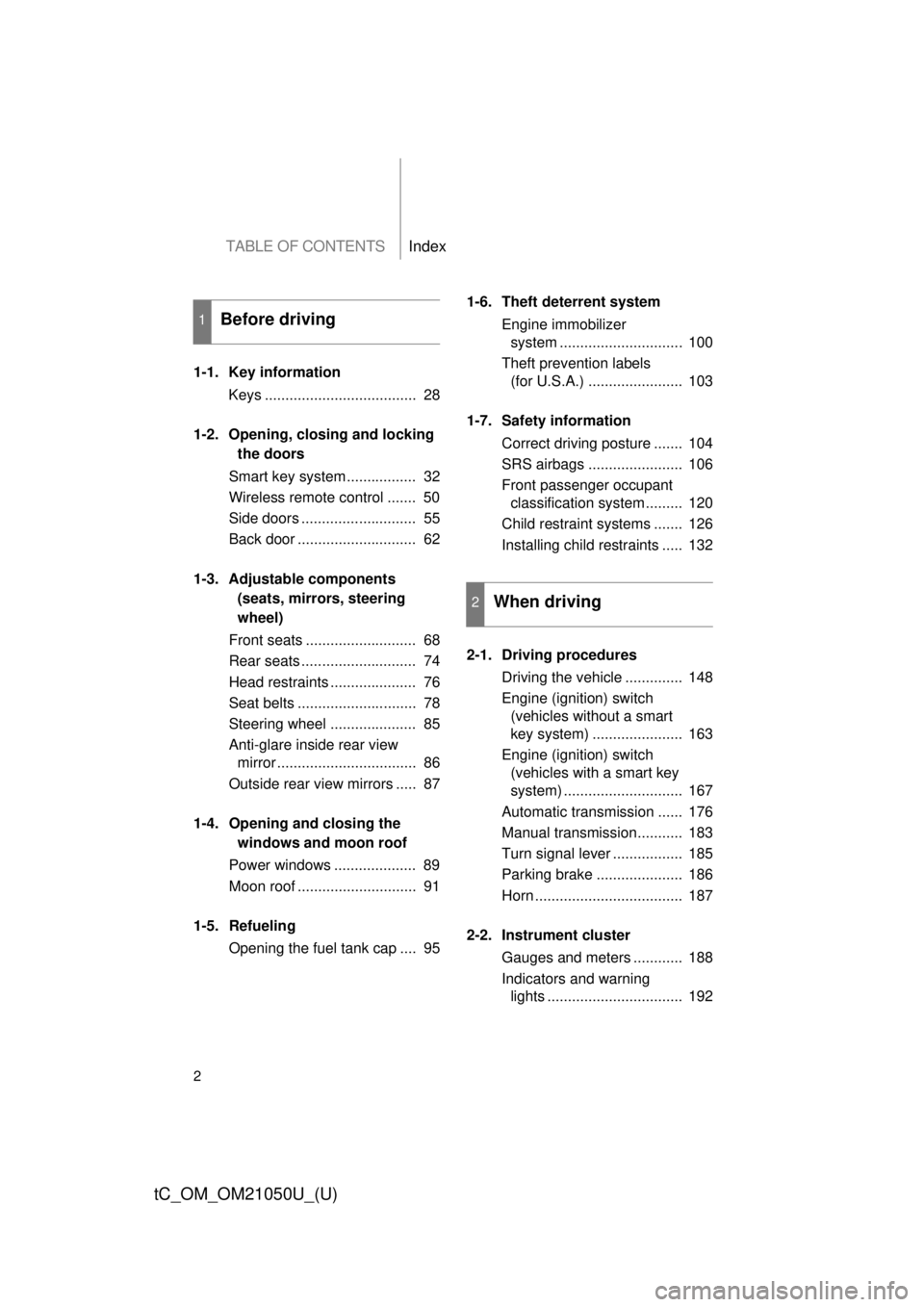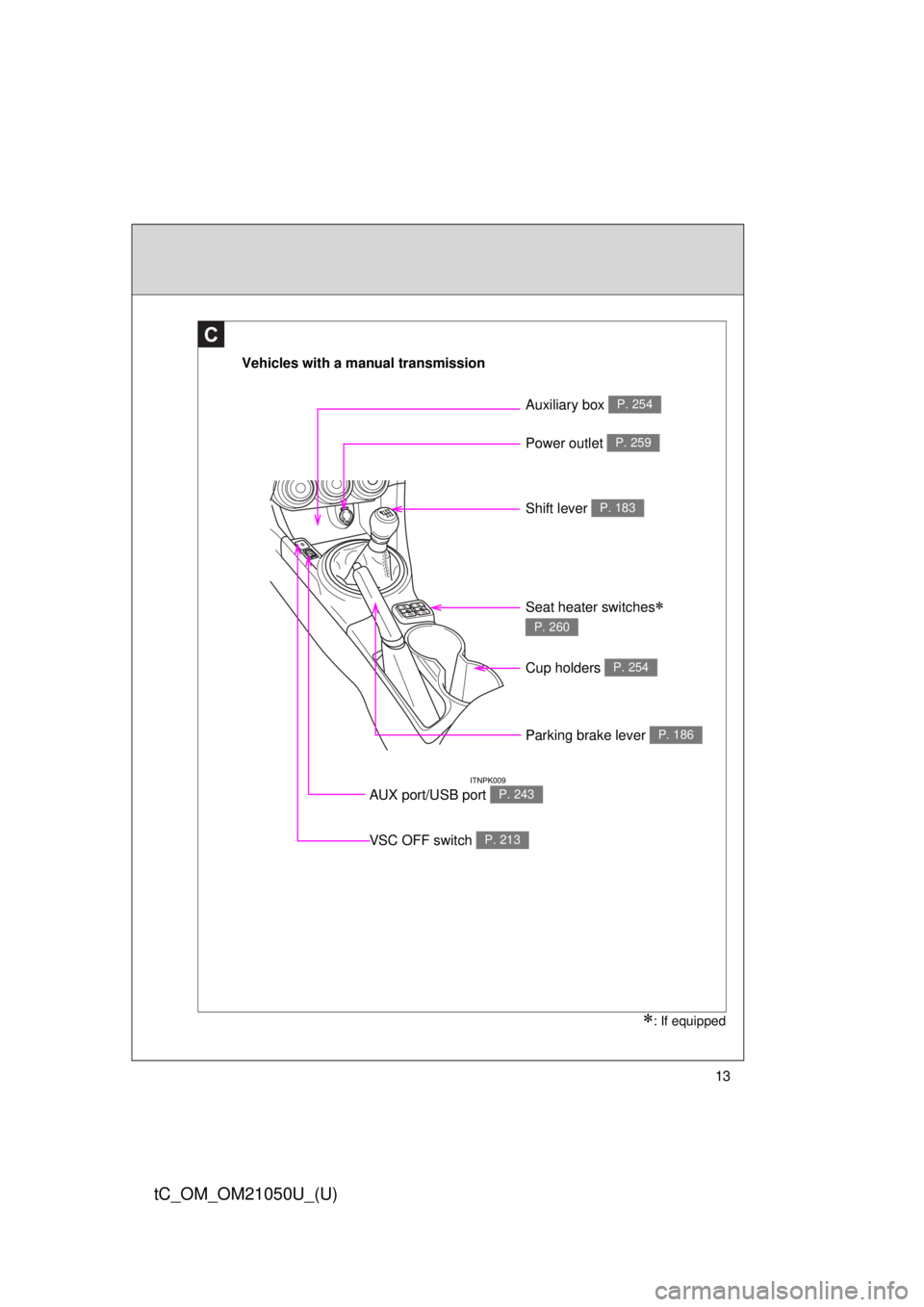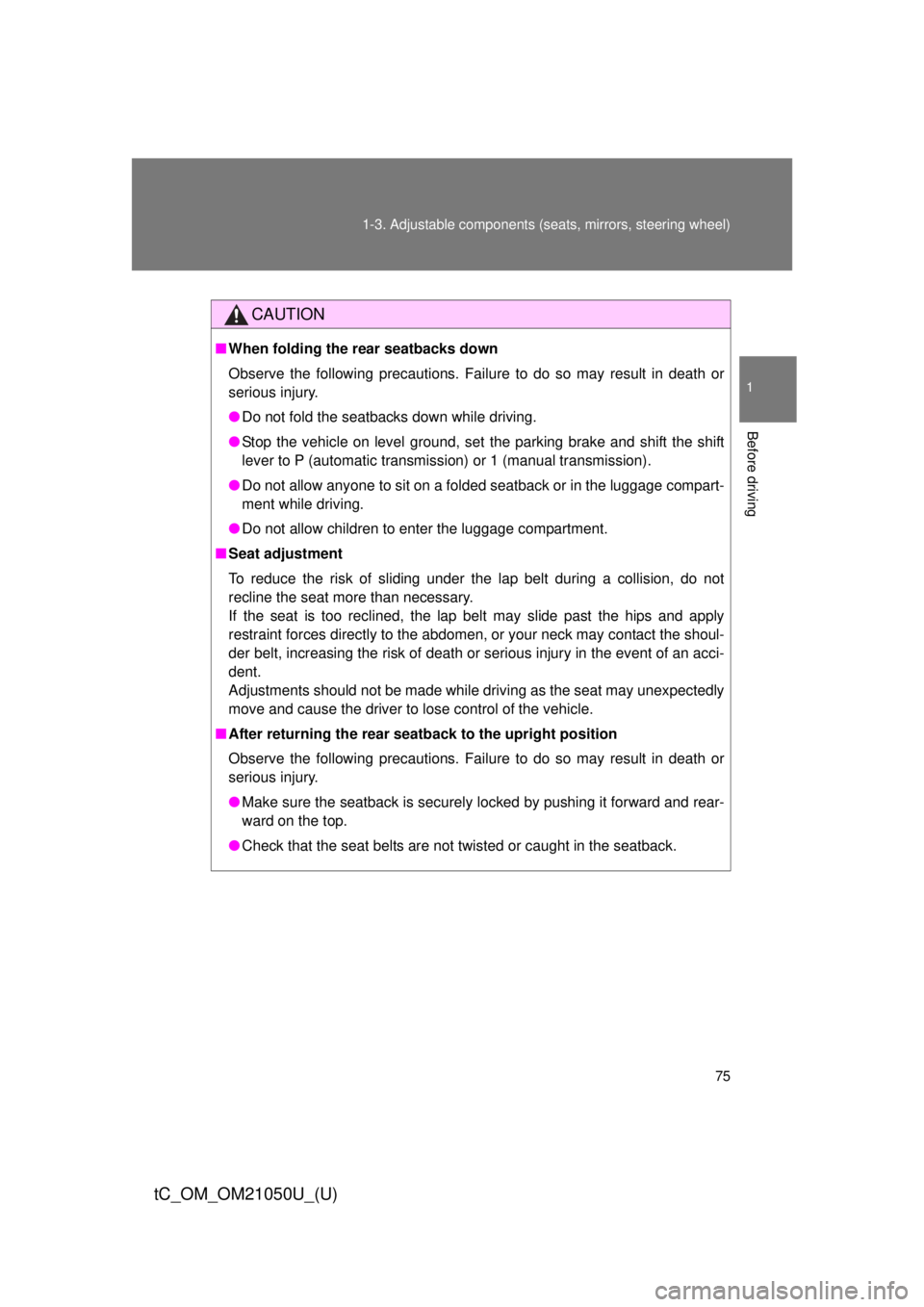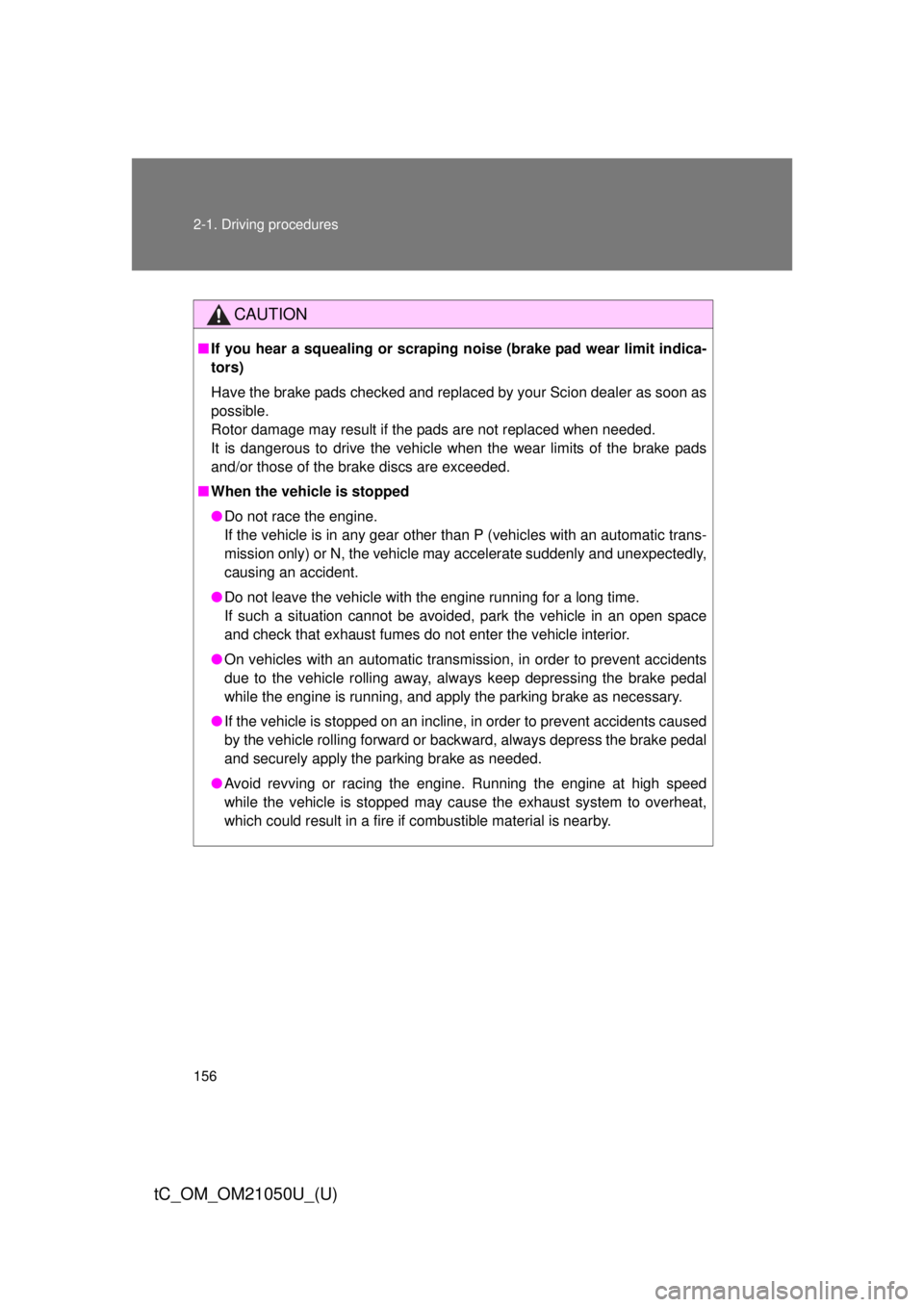parking brake TOYOTA tC 2013 Owners Manual (in English)
[x] Cancel search | Manufacturer: TOYOTA, Model Year: 2013, Model line: tC, Model: TOYOTA tC 2013Pages: 484, PDF Size: 9.41 MB
Page 2 of 484

TABLE OF CONTENTSIndex
2
tC_OM_OM21050U_(U)
1-1. Key informationKeys ..................................... 28
1-2. Opening, closing and locking the doors
Smart key system................. 32
Wireless remote control ....... 50
Side doors ............................ 55
Back door ............................. 62
1-3. Adjustable components (seats, mirrors, steering
wheel)
Front seats ........................... 68
Rear seats ............................ 74
Head restraints ..................... 76
Seat belts ............................. 78
Steering wheel ..................... 85
Anti-glare inside rear view mirror .................................. 86
Outside rear view mirrors ..... 87
1-4. Opening and closing the windows and moon roof
Power windows .................... 89
Moon roof ............................. 91
1-5. Refueling Opening the fuel tank cap .... 95 1-6. Theft deterrent system
Engine immobilizer system .............................. 100
Theft prevention labels (for U.S.A.) ....................... 103
1-7. Safety information Correct driving posture ....... 104
SRS airbags ....................... 106
Front passenger occupant classification system ......... 120
Child restraint systems ....... 126
Installing child restraints ..... 132
2-1. Driving procedures Driving the vehicle .............. 148
Engine (ignition) switch (vehicles without a smart
key system) ...................... 163
Engine (ignition) switch (vehicles with a smart key
system) ............................. 167
Automatic transmission ...... 176
Manual transmission........... 183
Turn signal lever ................. 185
Parking brake ..................... 186
Horn .................................... 187
2-2. Instrument cluster Gauges and meters ............ 188
Indicators and warning lights ................................. 192
1Before driving
2When driving
Page 12 of 484

12
tC_OM_OM21050U_(U)
Vehicles with an automatic transmission
Power outlet P. 259
Shift lever P. 176
Seat heater switches
P. 260
AUX port/USB port P. 243
Shift lock override button
P. 403
Pictorial indexInterior
C
Cup holders P. 254
Parking brake lever P. 186
VSC OFF switch P. 213
Auxiliary box P. 254
Page 13 of 484

13
tC_OM_OM21050U_(U)
Vehicles with a manual transmission
C
Power outlet P. 259
Shift lever P. 183
Seat heater switches
P. 260
AUX port/USB port P. 243
Cup holders P. 254
Parking brake lever P. 186
: If equipped
VSC OFF switch P. 213
Auxiliary box P. 254
Page 75 of 484

75
1-3. Adjustable components (s
eats, mirrors, steering wheel)
1
Before driving
tC_OM_OM21050U_(U)
CAUTION
■When folding the rear seatbacks down
Observe the following precautions. Failure to do so may result in death or
serious injury.
● Do not fold the seatbacks down while driving.
● Stop the vehicle on level ground, set the parking brake and shift the shift
lever to P (automatic transmission) or 1 (manual transmission).
● Do not allow anyone to sit on a folded seatback or in the luggage compart-
ment while driving.
● Do not allow children to enter the luggage compartment.
■ Seat adjustment
To reduce the risk of sliding under the lap belt during a collision, do not
recline the seat more than necessary.
If the seat is too reclined, the lap belt may slide past the hips and apply
restraint forces directly to the abdomen, or your neck may contact the shoul-
der belt, increasing the risk of death or serious injury in the event of\
an acci-
dent.
Adjustments should not be made while driving as the seat may unexpectedly
move and cause the driver to lose control of the vehicle.
■ After returning the rear seatback to the upright position
Observe the following precautions. Failure to do so may result in death or
serious injury.
● Make sure the seatback is securely locked by pushing it forward and rear-
ward on the top.
● Check that the seat belts are not twisted or caught in the seatback.
Page 147 of 484

When driving2
147
tC_OM_OM21050U_(U)
2-1. Driving proceduresDriving the vehicle............ 148
Engine (ignition) switch (vehicles without a
smart key system).......... 163
Engine (ignition) switch (vehicles with a smart
key system).................... 167
Automatic transmission .... 176
Manual transmission ........ 183
Turn signal lever .............. 185
Parking brake ................... 186
Horn ................................. 187
2-2. Instrument cluster Gauges and meters ......... 188
Indicators and warning lights .............................. 192 2-3. Operating the lights and
Windshield wipers
Headlight switch ............... 197
Windshield wipers and washer ........................... 201
Rear window wiper and washer ........................... 205
2-4. Using other driving systems Cruise control ................... 208
Driving assist systems ..... 212
2-5. Driving information Cargo and luggage .......... 217
Vehicle load limits ............ 222
Winter driving tips ............ 223
Trailer towing ................... 229
Dinghy towing (automatic transmission) ................. 230
Dinghy towing (manual transmission) ................. 231
Page 148 of 484

148
tC_OM_OM21050U_(U)
2-1. Driving procedures
Driving the vehicle
The following procedures should be observed to ensure safe driv-
ing:
■ Starting the engine
P. 163, 167
■ Driving
Automatic transmission With the brake pedal depressed, shift the shift lever to D. ( P. 176)
Release the parking brake. ( P. 186)
Gradually release the brake pedal and gently depress the
accelerator pedal to accelerate the vehicle.
Manual transmission While depressing the clutch pedal, shift the shift lever to 1. ( P. 183)
Release the parking brake. ( P. 186)
Gradually release the clutch pedal. At the same time, gently
depress the accelerator pedal to accelerate the vehicle.
STEP 1
STEP 2
STEP 3
STEP 1
STEP 2
STEP 3
Page 149 of 484

149
2-1. Driving procedures
2
When driving
tC_OM_OM21050U_(U)
■
Stopping
Automatic transmission With the shift lever in D, depress the brake pedal.
If necessary, set the parking brake.
If the vehicle is to be stopped for an extended period of time, shift
the shift lever to P or N. ( P. 176)
Manual transmission
While depressing the clutch pedal, depress the brake
pedal.
If necessary, set the parking brake.
If the vehicle is to be stopped for an extended period of time, shift
the shift lever to N. ( P. 183)
■Parking the vehicle
Automatic transmission With the shift lever in D, depress the brake pedal.
Set the parking brake. ( P. 186)
Shift the shift lever to P. ( P. 176)
If parking on a hill, block the wheels as needed.
Vehicles without a smart key system
Turn the engine switch to the “LOCK” position to stop the
engine.
Vehicles with a smart key system
Press the “ENGINE START STOP” switch to stop the
engine.
Lock the door, making sure that you have the key on your
person.
STEP 1
STEP 2
STEP 1
STEP 2
STEP 1
STEP 2
STEP 3
STEP 4
STEP 5
Page 150 of 484

150 2-1. Driving procedures
tC_OM_OM21050U_(U)
Starting off on a steep uphillAutomatic transmission Make sure that the parking brake is set and shift the shift lever
to D.
Gently depress the accelerator pedal.
Release the parking brake.
Manual transmission With the parking brake firmly set and the clutch pedal fully
depressed, shift the shift lever to 1.
Lightly depress the accelerator pedal at the same time as
gradually releasing the clutch pedal.
Release the parking brake.
Manual transmissionWhile depressing the clutch pedal, depress the brake
pedal.
Set the parking brake. ( P. 186)
Shift the shift lever to N. ( P. 183)
If parking on a hill, shift the shift lever to 1 or R and block the
wheels as needed.
Vehicles without a smart key system
Turn the engine switch to the “LOCK” position to stop the
engine.
Vehicles with a smart key system
Press the “ENGINE START STOP” switch to stop the
engine.
Lock the door, making sure that you have the key on your
person.
STEP 1
STEP 2
STEP 3
STEP 4
STEP 5
STEP 1
STEP 2
STEP 3
STEP 1
STEP 2
STEP 3
Page 156 of 484

156 2-1. Driving procedures
tC_OM_OM21050U_(U)
CAUTION
■If you hear a squealing or scraping noise (brake pad wear limit indica-
tors)
Have the brake pads checked and replaced by your Scion dealer as soon as
possible.
Rotor damage may result if the pads are not replaced when needed.
It is dangerous to drive the vehicle when the wear limits of the brake pads
and/or those of the brake discs are exceeded.
■ When the vehicle is stopped
● Do not race the engine.
If the vehicle is in any gear other than P (vehicles with an automatic trans-
mission only) or N, the vehicle may accelerate suddenly and unexpectedly,
causing an accident.
● Do not leave the vehicle with the engine running for a long time.
If such a situation cannot be avoided, park the vehicle in an open space
and check that exhaust fumes do not enter the vehicle interior.
● On vehicles with an automatic transmission, in order to prevent accidents
due to the vehicle rolling away, always keep depressing the brake pedal
while the engine is running, and apply the parking brake as necessary.
● If the vehicle is stopped on an incline, in order to prevent accidents caused
by the vehicle rolling forward or backward, always depress the brake pedal
and securely apply the parking brake as needed.
● Avoid revving or racing the engine. Running the engine at high speed
while the vehicle is stopped may cause the exhaust system to overheat,
which could result in a fire if combustible material is nearby.
Page 158 of 484

158 2-1. Driving procedures
tC_OM_OM21050U_(U)
CAUTION
●Always apply the parking brake, shift the shift lever to P (vehicles with an
automatic transmission only), stop the engine and lock the vehicle.
Do not leave the vehicle unattended while the engine is running.
● Do not touch the exhaust pipe while the engine is running or immediately
after turning the engine off.
Doing so may cause burns.
● Do not leave the engine running in an area with snow build-up, or where it
is snowing. If snowbanks build up around the vehicle while the engine is
running, exhaust gases may collect and enter the vehicle. This may lead
to death or a serious health hazard.
■ Exhaust gases
Exhaust gases include harmful carbon monoxide (CO), which is colorless
and odorless. Inhaling exhaust gases may lead to death or a serious health
hazard.
● If the vehicle is in a poorly ventilated area, stop the engine. In a closed
area, such as a garage, exhaust gases may collect and enter the vehicle.
This may lead to death or a serious health hazard.
● The exhaust system should be checked occasionally. If there is a hole or
crack caused by corrosion, damage to a joint or abnormal exhaust noise,
be sure to have the vehicle inspected and repaired by your Scion dealer.
Failure to do so may allow exhaust gases to enter the vehicle, resulting in
death or a serious health hazard.